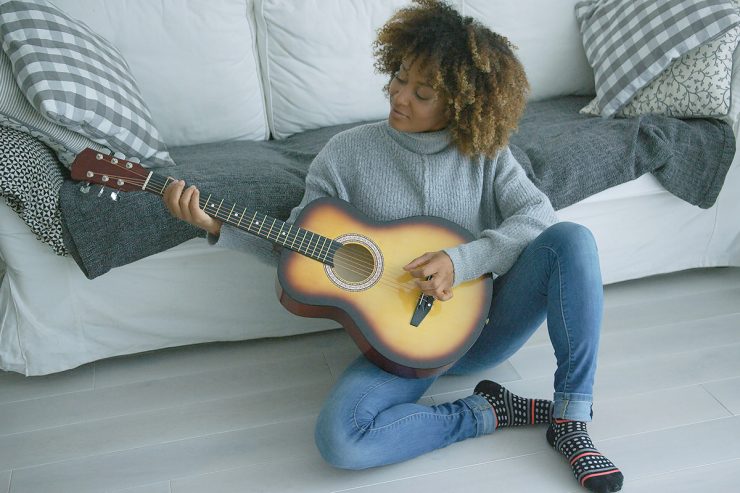Every guitarist remembers their first identity crisis. It wasn’t deciding between Strat or Les Paul, or whether to admit they secretly enjoy John Mayer’s playing—it was the moment they had to choose between sitting or standing. This seemingly innocent postural decision carries shocking implications that will follow you throughout your guitar journey like that one relative who keeps asking when you’re going to get a “real job” instead of “doing the guitar thing.” Standing players often view their seated counterparts as academic technicians afraid to embrace the full rock and roll lifestyle, while sitting players view standers as style-over-substance posers who would rather jump around than nail that diminished arpeggio. The truth, of course, is that most guitarists are posture-fluid, switching between positions depending on the musical context, their energy level, or how recently they’ve thrown out their back attempting to move their own amp. Nevertheless, the sitting/standing dichotomy remains guitardom’s Mason-Dixon line, silently categorizing players into tribes that occasionally eye each other suspiciously across music store demonstration rooms.
“Standing up to play guitar makes you look cooler, but sitting down lets you play cooler stuff. It’s the eternal musician’s dilemma: do you want to look good or sound good?”
— Dave Grohl (allegedly)
The sitting guitarist species comes in several distinct varieties. First, we have the Classical Position Purists, left foot elevated on a footstool, guitar balanced precisely on the left thigh, spine straight enough to make a military drill instructor weep with joy. These players can discuss proper thumb position for hours and own at least one shirt with actual buttons. Then there are the Casual Crosslegs, often found in coffee shops massacring “Wonderwall” with their instrument balanced precariously on whatever leg felt right in the moment. Most fascinating are the Metal Bedroom Shredders, who adopt the “classical” position not from traditional training but because it’s physically impossible to play 32nd-note sweeps at 180 BPM while standing unless your name is Herman Li. What unites all sitters is the prioritization of technical facility and comfort over stage presence—a pragmatic approach that says, “I’d rather nail this passage than look cool failing at it.” Sitters tend to be methodical practicers, meticulous about technique, and are statistically 87% more likely to own a metronome they actually use. Their greatest fear isn’t stage fright but rather being handed a wireless unit and told to “move around a bit more.”
Standing guitarists are the peacocks of the musical world—magnificent in full display, slightly awkward when at rest. These upright musicians come in various forms, from the Statue (who has found the one position that doesn’t hurt their back and will not deviate from it under any circumstances) to the Full Aerobic Workout (who burns more calories during a guitar solo than most people do in a spin class). The Strap Height Hierarchy is strictly enforced among standers: jazz and blues players keep their instruments at a sensible, playable height; rock guitarists slightly lower; metal guitarists at hip level; and punk guitarists so low they’re essentially playing a bass. Standing players universally share the experience of “first gig strap soreness”—that peculiar next-day shoulder pain that feels like you’ve been lugging around a small child rather than a 9-pound instrument. What truly distinguishes standers is their commitment to the visual aspect of music—they understand that guitar playing isn’t just about the notes but about the full performance experience. Their practice sessions frequently involve unexpected collisions with ceiling fans, lamps, and unsuspecting pets as they perfect moves in front of bedroom mirrors. Their greatest pride is not their tone or technique but that one photo where they looked exactly like their guitar hero for 1/250th of a second.
The Pragmatic Truth: Context Is Everything
Beyond the tribal affiliations lies a practical reality: different playing contexts demand different postures. Even the most dedicated sitter must acknowledge that attempting to perform “You Really Got Me” while perched on a barstool somewhat diminishes the raw animal energy the song demands. Conversely, even diehard standers must concede that attempting Bach’s Chaconne while prowling the stage like a caged panther might not serve the music’s contemplative intricacy. Most working guitarists develop a context-based approach: sitting for practice, recording, and intimate acoustic performances; standing for high-energy gigs and whenever there’s a photographer present. This practical flexibility extends to guitar design itself—note how classical guitars feature design elements specifically for seated playing, while Flying Vs practically demand to be played standing unless you enjoy the unique thigh-gouging pain they provide when seated. The wisest guitarists recognize that posture is just another tool in the expressive arsenal, to be deployed strategically depending on musical needs. Like choosing between fingerstyle and pick playing, or deciding when to use vibrato, the sitting/standing question ultimately resolves to: “What does this music need right now?” followed immediately by, “And how does my back feel today?”
Health Implications: The Orthopedic Elephant in the Room
The humor of the sitting/standing debate fades somewhat when we acknowledge the physical toll that guitar playing takes on the human body. Both positions present distinct health challenges that have ended careers and caused chronic pain for countless players. The seated classical position, while offering optimal left-hand access, frequently leads to right shoulder elevation and neck tension. The casual seated position often creates asymmetrical spinal loading and potential disc issues. Standing with a guitar creates its own problems—particularly the infamous “guitarist’s hunch” developed from years of looking down at the fretboard while standing, not to mention the left shoulder strain from supporting the instrument. These concerns become increasingly relevant as playing years accumulate, which explains why so many veteran guitarists eventually migrate toward shorter sets, lighter instruments, and—yes—more sitting. The ergonomics revolution in guitar design attempts to address these issues with innovations like the Steinberger headless design, the Parker lightweight concept, and various ergonomic straps and supports. Perhaps the healthiest approach is postural variety—alternating between sitting and standing during practice sessions, adopting proper technique in both positions, and being mindful of tension patterns. After all, the most important long-term question isn’t whether you play sitting or standing, but whether you can continue playing comfortably into your golden years, when jumping off the drum riser becomes less viable both musically and orthopedically.
8 Guitar Legends and Their Preferred Playing Positions
1. Jimi Hendrix: Standing
The ultimate standing guitarist who made his instrument an extension of his body, Hendrix occasionally sat for acoustic blues but stood for nearly all his iconic performances. His preferred strap height was moderately low, allowing him to manipulate the guitar with his teeth, behind his back, and—memorably—set it on fire while maintaining proper control.
2. Andrés Segovia: Sitting
The classical maestro who legitimized guitar as a concert instrument was absolutely dedicated to proper seated classical position. He was known to stop performances to adjust his footstool if it wasn’t providing the exact angle he required, and reportedly once refused to play in a venue that couldn’t provide a suitable chair.
3. Angus Young (AC/DC): Standing
Not only standing but in perpetual motion, Young personifies the guitar as performance art. His schoolboy uniform and duck-walk would be physically impossible to execute while seated, proving that sometimes the visual component is inseparable from the musical identity.
4. Django Reinhardt: Sitting
The jazz guitar pioneer preferred the seated position, which accommodated both his lightning-fast technique and the physical limitations caused by injuries to his fretting hand. Vintage photos show him seated even during performances, focusing intensely on his revolutionary fingerwork.
5. Joan Jett: Standing
The rock icon has consistently performed standing, with her guitar slung relatively low in classic punk position. Jett’s powerhouse rhythm playing and commanding stage presence demonstrate how standing position can enhance musical authority and performance energy.
6. B.B. King: Both
The blues legend began his career standing but gradually transitioned to seated performances as he aged. Later in life, he developed a signature seated performance style, demonstrating how a master can command absolute attention without standing. His evolution offers a template for aging guitarists concerned about longevity.
7. Joe Satriani: Standing
The technical wizard proves that even the most complex instrumental passages can be executed standing. Satch maintains a moderate strap height that allows for technical facility while still preserving mobility, challenging the notion that advanced technique requires seated playing.
8. Kaki King: Primarily Sitting
The percussive fingerstyle innovator generally performs seated, particularly when executing her complex two-handed tapping techniques. Her approach demonstrates how certain advanced techniques benefit from the stability and access that seated playing provides, though she occasionally stands for less technically demanding material.



































